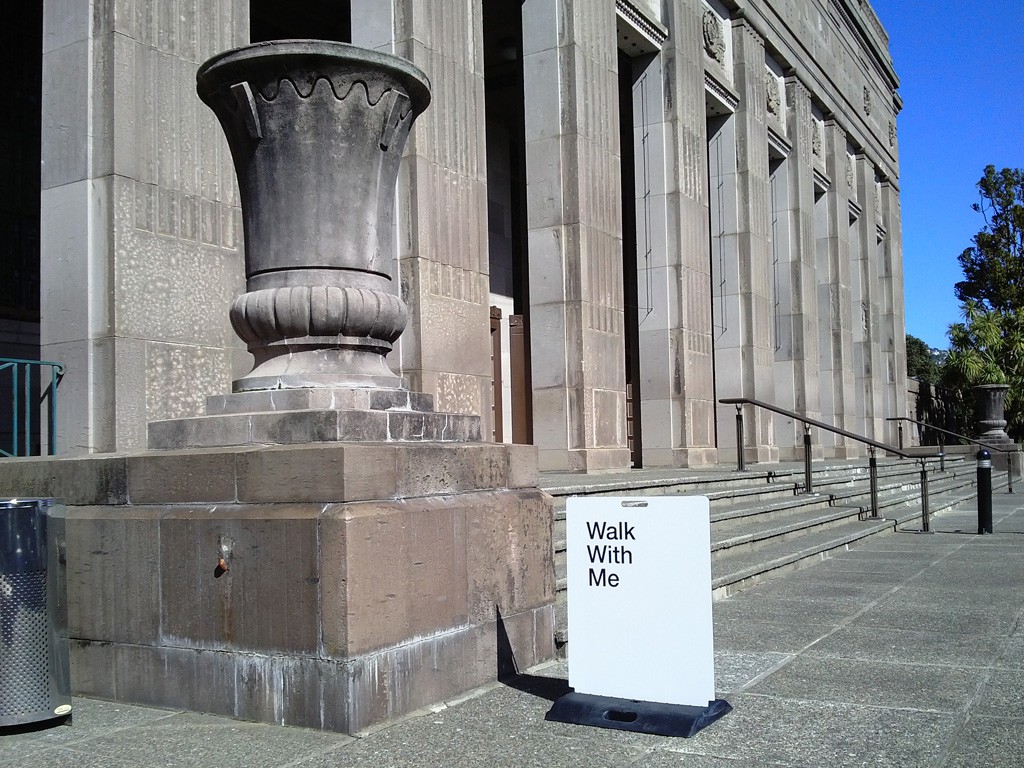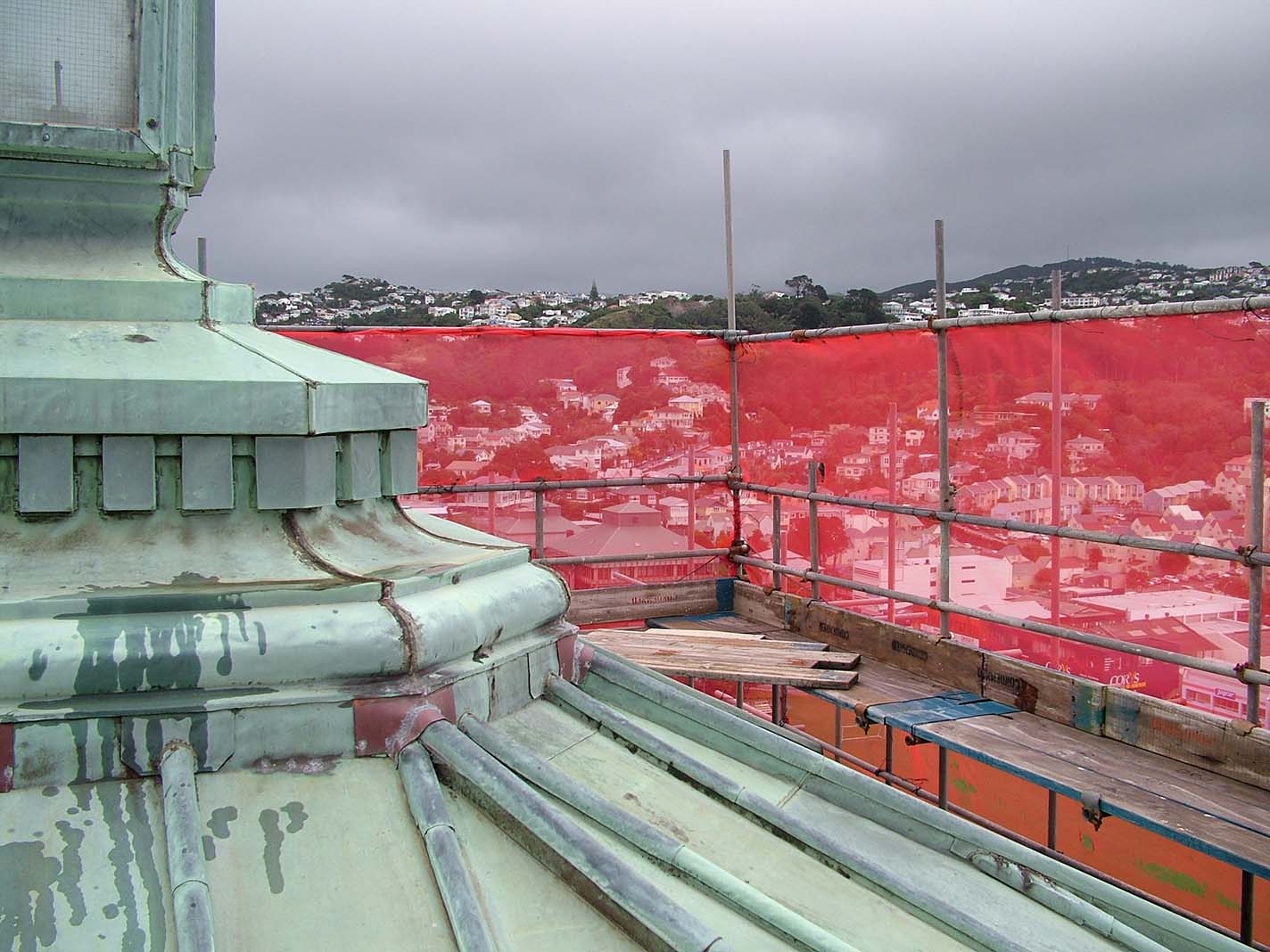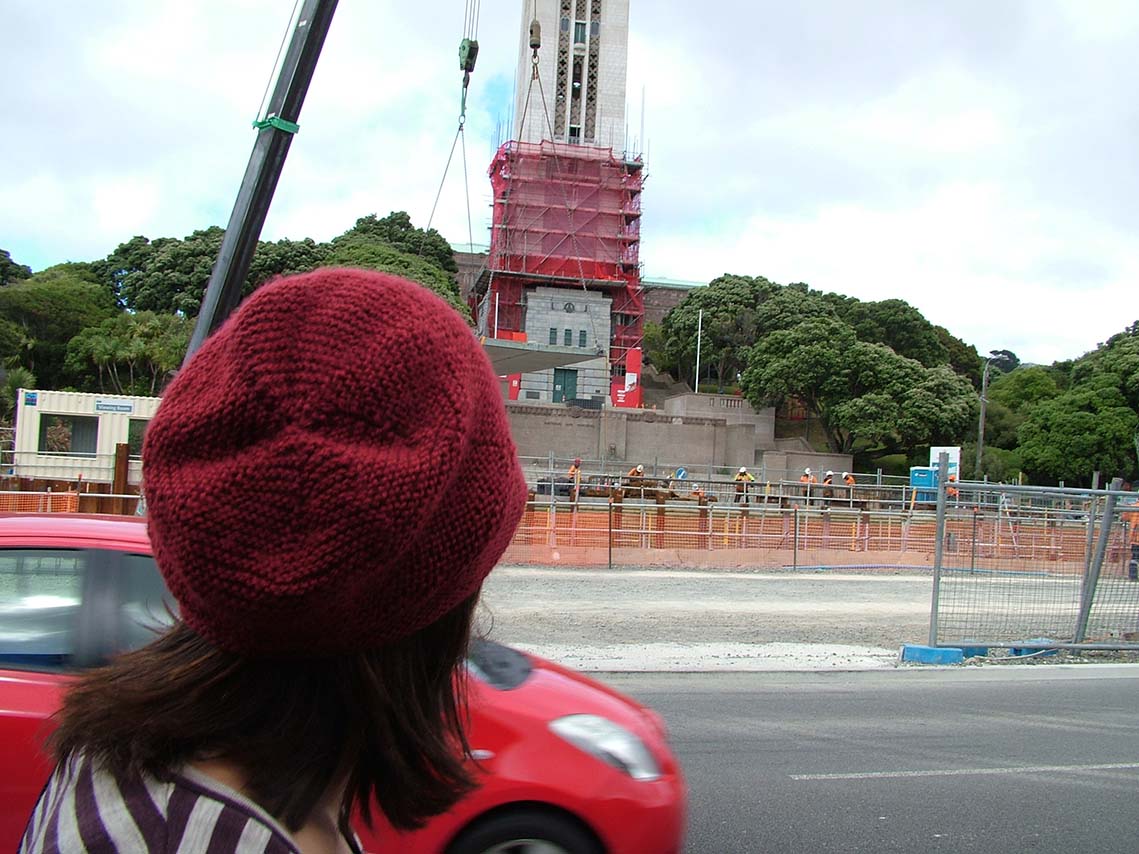Performing the Personal Essay: Encounters with Pukeahu
Angela Kilford
Angela Kilford, Te Whānau A Kai, Ngāti Porou, Ngati Kahungunu, is an artist based in Wellington. Her practice investigates memory, memorialisation and landscape. Recent projects, including her MFA work in the College of Creative Arts at Massey, demonstrate a keen interest in contested memories within specific sites and seek to elevate oral histories as a means of recording the past. In this essay Kilford writes about her experience of visiting Pukeahu National War Memorial Park multiple times. She combines her experience as an artist guiding people around the park with reflections of the site’s history and her own connection with the land.

On the southern edge of Buckle Street, the fleeting sounds of birds and singing cicadas clash with the metal on metal of the construction site. Adding to the suite of temporal notes is the convivial voice of a 42-year-old artist conversing with her tour participants. Above and below, the pohutukawa trees, anchored deeply in the ground by tendrils wrapped firmly around the old munitions buried a century before.
Ko Takitimu te Waka
Ko Rongopai te Marae
Ko Maungatapere, me Okahuiatiu, me Maunga Haumi, nga maunga tapu
Ko Waipaoa, me Repongaere, me Waikakariki nga awa
Ko Whanau A Kai te hapu
Ko Te Aitanga a Mahaki te iwi
Ko Wi Pere te tangata
Ko Angela Kilford ahau
Tena koutou, tena koutou, tena koutou katoa
The Māori practice of reciting mihimihi or pepeha describes the connections between a person, their tipuna and the land. The pepeha recorded at the beginning of this essay refers to physical features of the landscape that are of particular significance to my family. Of broader significance is the connection that Māori hold with the land and also with spiritual ancestors who embody the physical landscape. The word for land, ‘whenua’, has more than one meaning. Most commonly whenua refers to land or earth, but it also stands for placenta or afterbirth. It is Māori tradition to bury the whenua in the ground to replenish the earth in return for the nourishment and shelter it provides. Ranginui Walker, author of Ka Whawhai Tonu Matou: Struggle Without End, explains that burying the whenua also acts to strengthen the bond between a person and their place of belonging. It was a feeling of unease and even fascination that drew me to investigate Puke Ahu, a place being offered as a national site for remembrance.
Geographically, Puke Ahu is a small hill between two rivers.
A stream runs down the path of Taranaki Street and now passes underneath the hill.
Another stream begins near the hospital and flows along Adelaide Road and although it is now covered, it runs all the way to the sea.
Local Māori once cultivated their gardens on this land.
The view from Puke Ahu would have been lush and green.
When the early settlers arrived in the 1840s, Puke Ahu would have been the most logical site to establish military defence, a vantage point for setting up a military barracks, police station, and even a gaol.
In 1882 a huge prison was built on Puke Ahu. The prison was four stories high and had 381 Cells, two watchtowers and an exercise yard.
The prison brickworks produced 18 million bricks to build the prison using clay from Puke Ahu and the prisoners provided free labour.
The ideas of pepeha, whakapapa and whenua are important as they emphasise a valuing of land that is not connected to money or ownership. Sir Hirini Mead describes tikanga Māori as practices and laws that exist in order to negotiate situations and events. Tikanga are formed through responses to matauranga Māori, a body of knowledge that is passed down through generations. This knowledge is organised as whakapapa and can be traced back to the time before there was light in the world, before there was darkness, to a time where all that existed was potentiality.
The prison was repurposed as a military barracks and later demolished to make way for the Dominion Museum and Art Gallery, which opened in 1936.
However, it wasn’t long before the military occupied that building too. Due to WWII the RNZAF moved into the Museum and Art Gallery from 1942–1947. It was reopened as a Museum in September 1949.
In April 2015 the military will once again have a presence on Puke Ahu when the WW1 Temporary Commemorative exhibition opens.
A monument is positioned on the northwestern corner of the land that the Old Museum Building, Tokomaru, is built on. This memorial acknowledges the peaceful protestors of Parihaka who were held in a prison at the same site in the 1880s. The rock cairn memorial is humble in comparison to the 50 metre high, concrete and stone construction of the National War Memorial, which was dedicated on Anzac Day in 1932. The Parihaka Memorial tells part of the story of a displaced people and is the only recognition of the foundation wars of New Zealand at the site. The Parihaka Memorial sits slightly apart from the National War Memorial on land owned by Te Atiawa Iwi. This is a reminder of the Tangata Whenua of Wellington and brings forth a Māori understanding of land and the significant role of myth as contributing to a sense of national identity.
We’re on quite a tight time schedule, but we could probably take a look at the Parihaka Memorial.
Parihaka was a pacifist community in Taranaki in the 1800s.
This memorial honours the peaceful protestors that were taken from Parihaka and imprisoned unlawfully before being shipped further south as slave labour.
The tangata whenua of Wellington, Te Atiawa originally came from Taranaki and own this piece of land (under the Wellington Tenths Trust) along with the land that the museum building is sitting on. That’s why the Parihaka Memorial is on that particular corner of land. As a memorial it acknowledges the foundation wars of New Zealand.
The building of monuments and memorials is a way for a nation to construct a desired narrative for an observing public. The constructed narrative, according to A.S. Byatt, is reinforced by the use of flags, the naming of civic buildings and parks and also the ritual ceremonies organised by government institutions. These different aspects of remembrance are termed by French theorist, Pierre Nora, as realms of memory or les lieux de mémoire. Every aspect of embodied memory whether material, symbolic, or functional exists to form les lieux de mémoire. In the case of the National War Memorial, these realms of memory contribute to an historical awareness of what it is to be a New Zealander and provide a context for a national identity to emerge.
Myth is important to both Pakeha and Māori in the forming of a collective or national identity. The foundational myth of Māori, though not promoted to the extent of the myths associated with war commemoration, is central to a Māori understanding of the world. In the spirit of oral histories I will now relay the Māori story of creation in my own words:
In the beginning there was nothing,
Te Kore.
Then there was the energy, the power of potential,
Te Po.
From the energy and darkness emerged Ranginui the sky and Papatuanuku the earth.
Many sons came from within their close embrace.
The sons grew restless trapped between the forms of their father and mother.
Eventually Tanemahuta, with his head and hands butting against his mother pushed his legs upwards to lever Ranginui and Papatuanuku apart,
Te Ao Marama.
In the world of light the sons fought.
Tawhirimatea eventually retreated to reside with Ranginui.
Haumiatiketike and Rongomatane stayed with Papatuanuku, where they were protected
Tangaroa, is Atua of the sea and all of its creatures.
Tumatauenga turned on his brothers and became the Atua of war.
Tanemahuta, Atua of birds and forests, formed the first human from the Earth, Hineahuone.
The Māori story of creation demonstrates a connection to the land through whakapapa, which can be traced back through the realms of the Atua to Papatuanuku, the earth mother, and Ranginui, the sky father. Walker describes the love that Papatuanuku received from her children, as a love that all nurtured children would have for a mother. This story characterises Māori as people deeply affiliated to the land and affects the practices of Māori when interacting with the natural world, as the intangible realm of the Atua are intrinsically related to the realm of the living. It is through the whakapapa illustrated in the story that Māori are connected to the Atua and also the land. The fact that Māori are related to Papatuanuku through whakapapa seriously affects their treatment of the land and has further implications when considering any interaction with it. From the planting of new crops to the excavation of large areas, the relationship to Papatuanuku is always considered and acknowledged.

When visiting a new city memorials and monuments are often at the top of the list of places to visit and as of 25th April 2015 our new memorial park will be no exception.
What are we looking at? Remember Buckle Street?
The project partners use a cut and cover technique. It’s just like cutting a wedge of cake really. A slice of earth 300m long, 18m wide, 12m. The cost is approximately $120 million.
Normally it would take about two years to process the consents for the underpass and twice as long to build it.
There is a 90m steel sheet pile wall to hold back the water table and stabilize the ground.
35,000m3 of soil gouged out of the hill.
7,500 m3 of concrete and 2,598 tonnes of steel reinforcing replace the soil.
558 ground anchors; each 13m long are stabbed through the concrete and into the rock.
16,000 bags of cement to hold the ground anchors in place
95 concrete piles are pummelled 30 metres into the greywacke stone.

From the first day that I visited the site with my camera with the intention of documenting the initial stages of excavation, I was in awe of how a landscape I thought I knew could swiftly change. On this day I was involved in an accident on the site as a barrier fence fell and trapped me beneath it. As I lay face down with my camera lens pushed into my ribs, head to one side and hands flattened against the cold bitumen, pieces of aggregate embossed my skin. I pushed up naively unaware of the steel pole lodged between my shoulder blades. Panic swelled then dispersed from my stomach up to my face, like a fine lace of emotion. The thought that there might be more steel, another blow yet to come spurred me to cry out for help. From that moment, I felt connected to the site by the trauma of the event and from the displacement associated with a rapidly changing environment. The need to come to terms with the ruthless excavation of a sacred hill steeped in memory, has enabled me to persistently scour the site for traces of memory until I could feel that I genuinely knew the story of that place.
Conscientious objectors to the First World War walked this path in 1917.
They were marched through the centre of Wellington, then along here on their way to the Prison brickworks. Here they were ordered to work. They refused to work under military orders and were punished accordingly.
They were imprisoned for three days without mattresses and just bread to eat. Archie Baxter reported that he could see all of Wellington from his cell on the 4th floor.
To Puke Ahu I offer this song of peace.
Te aroha
Te whakapono
Me te rangimarie
Tatou tatou e